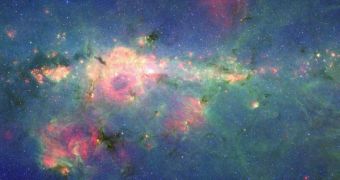For a long time, astronomers studying the formation of massive stars have been puzzled at how the giant celestial bodies, some 120 times larger than our Sun, can expand without “chasing away” the dust and gas clouds that feed their growth. According to a new theory, this relative stability can be explained by the fact that many of these giant stars are formed in binary or multiple star systems, which makes it somehow easier for them to fuel their growth from the clouds around.
In a study that appeared online on January 15th, in the online edition of the Science Express journal, researchers at the Lawrence Livermore National Laboratory (LLNL), working with colleagues at the University of California, in Santa Cruz and UC Berkeley, note that the gravitational forces that are exerted within this type of star systems are massive enough to trigger the formation of smaller stars near the gigantic ones.
Basically, what the team is saying is that the radiation emitted by large stars, which was previously thought to push dust and gas clouds outwards and thus prevent them from growing, actually has little influence on the accretion process of such celestial bodies. This phenomenon is associated with a star's ability to increase to massive sizes via pulling in matter from its surroundings.
“Originally, we were just exploring the physics of massive star formation. As we were looking at the physics, we found that gravitational instabilities cause companion stars to form around massive stars,” Richard Klein, a researcher at LLNL and an adjunct professor at UC Berkeley, explains.
“We didn't set out to solve that question, so it was a nice side benefit of the study. The main finding is that radiation pressure does not limit the growth of massive stars,” study lead author Mark Krumholz, who is an UC Santa Cruz assistant professor of astronomy and astrophysics, adds.
“Logically, we thought the massive amounts of radiation pressure would stop the star in its tracks from growing any larger. But instead, gravitational instabilities channeled gas onto the star system through disks and filaments, sort of like fingers, that self-shield against the radiation, while allowing the radiation to escape through optically thin bubbles,” Klein concludes.

 14 DAY TRIAL //
14 DAY TRIAL //